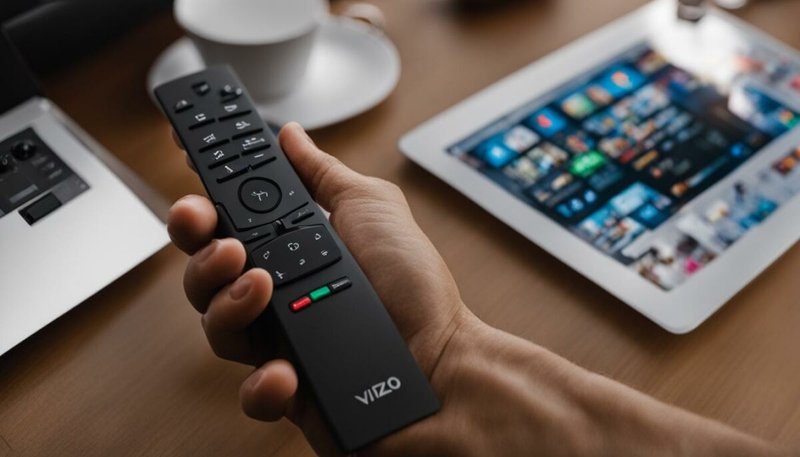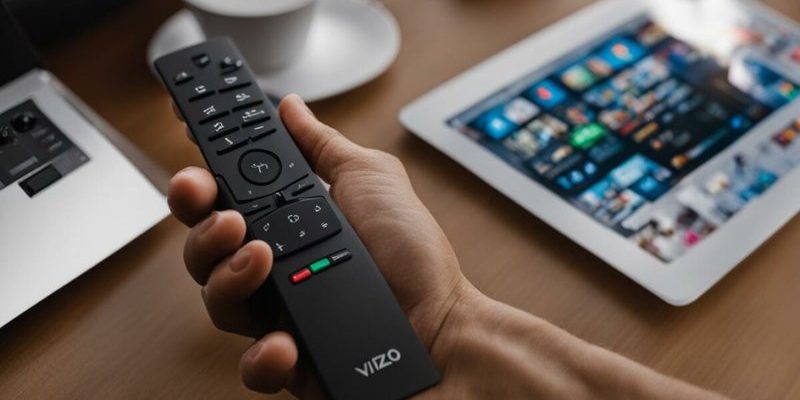
Honestly, when I got my first Vizio TV, I had zero clue that the remote could do more than just turn the TV on and off. Fast-forward a few months, and I’m controlling my soundbar, my streaming stick, even adjusting my HDMI switcher — all with that same remote. It’s like discovering your Swiss Army knife has a secret screwdriver hidden in the handle. Let me walk you through how to take charge of your own entertainment system and reclaim your coffee table space.
What Makes Vizio TV Remotes Special?
Here’s the thing: not all remotes are created equal. Some are stubbornly loyal to just one device—like that friend who refuses to try pineapple pizza. Vizio TV remotes, on the other hand, come with the ability to communicate with other devices plugged into your TV. This is possible because of CEC (Consumer Electronics Control) and Universal Remote features.
CEC lets devices talk to each other through your HDMI cables—so your TV remote can send commands to things like soundbars, game consoles, or streaming boxes, just by using the same wire they use for video. Honestly, it’s like a group chat for your electronics (and way less annoying than the actual group chats in my life).
Some Vizio remotes are also equipped to act as universal remotes, meaning you can program them with special codes to control devices from other brands. If you’ve ever searched for “remote control codes,” you’ve dipped your toes into this world. So, whether your Vizio remote relies on built-in magic or some old-school code syncing, there’s power in that little rectangle.
Setting Up Device Control: HDMI-CEC Magic
For most people, the real game-changer is HDMI-CEC. Vizio calls their version “CEC,” but you might’ve seen it called “CEC,” “Bravia Sync,” or “Anynet+” on other brands. When enabled, your Vizio remote can suddenly reach out and control any CEC-enabled device connected through HDMI.
Here’s how you make the magic happen:
- First, make sure everything’s connected using HDMI cables. The CEC feature only works over HDMI—those old red, white, and yellow cables can’t help you here.
- On your Vizio TV, go into the Settings menu (usually a gear icon), and look for “System” then “CEC.” Turn that baby ON. Some Vizio models might call it “HDMI Control.”
- Next, check your other devices. They need to have CEC enabled, too. Sometimes you have to dig around in their settings. If you see something called “Device Link” or “HDMI Control,” flip it on.
- Once everyone’s speaking CEC, try controlling your soundbar or your streaming box with the Vizio remote. Boom—volume goes up, input switches, power toggles right along with the TV.
I remember the first time I walked past my coffee table, realized I hadn’t touched the soundbar remote in a week, and thought: *Whoa, did I finally declutter my life?* There’s a special kind of peace in having just one remote rule them all.
Programming Universal Codes Into Your Vizio Remote
Let me explain this part, because it’s honestly where most folks get tripped up. Some Vizio remotes, especially the chunkier ones with lots of buttons, have a true universal remote mode. This is a little more old-school but super powerful.
You might be wondering: how does this work? Basically, you enter a code (a bit like a secret handshake) to sync the Vizio remote with your other device. Here’s how you dig in:
- Pull up the manual for your Vizio remote or hop online to Vizio’s support pages. Look for the code list for your device (soundbars, DVD players, etc.).
- On the remote, press and hold the device button—like “AUX” or “CBL”—until the indicator light stays on.
- Type in the code for your device model. If the light blinks twice and then stays steady, you’re golden. If it does nothing, try the next code in the list.
- Test it out. Try powering on and off, changing the volume, or whatever function you need.
It’s honestly kind of satisfying when a four-digit number suddenly gives you superpowers. The first time I programmed a remote, I felt like I’d cracked a secret code used by spies. If only it also did my laundry.
Troubleshooting Common Sync Issues
Let’s be real for a second: technology is amazing, but it also loves to throw curveballs. Maybe your Vizio remote worked like a charm yesterday, but suddenly it won’t control your soundbar. Or maybe after resetting your TV, nothing seems synced anymore.
Here are the usual suspects, and how to tackle them:
- Batteries. It sounds silly, but weak batteries can cause weird glitches. Replace them before you start blaming the remote’s soul.
- Device is asleep. Some soundbars and streaming boxes don’t respond when they’re in deep sleep mode. Try unplugging and plugging them back in.
- HDMI cables aren’t CEC-friendly. Not all HDMI cables support CEC, especially cheaper or ancient ones. Swap it out and test again.
- Something needs a reset. Sometimes just turning everything off—TV, devices, power bar—waiting a full minute, then powering back up, does the trick. Oldest trick in the book but still golden.
If you ever see the remote behaving super oddly (like not controlling the TV at all), try a reset on the remote itself: remove the batteries, hold every button down for ten seconds, pop them back in, and re-pair if needed. Sounds odd, but it can shake the ghosts out.
When Universal Doesn’t Mean *Universal*
Here’s a dose of tough love: even the best Vizio TV remote isn’t a miracle worker. Some devices just refuse to cooperate. Maybe your older DVD player doesn’t speak CEC, or your gaming console insists on its own controller.
This is where universal remotes, like those from Logitech or GE, sometimes outshine the built-in Vizio remote. They support more device types and can offer extra features, like custom macros or voice control. But the trade-off is another purchase (and probably a more complicated setup). If you’re pretty happy just managing a couple devices, your Vizio remote gets you most of the way there.
If you have a pile of vintage gear, or you want to dim the lights and close the blinds all with one button, a true universal remote might be worth the jump. But for most setups, I’ve found the Vizio remote covers the basics beautifully.
Pro Tips for the Smoothest Remote Experience
You might think, “Okay, I’ve got everything paired, but is there any way to make it even easier?” Glad you asked. Here are a few tricks I’ve picked up after way too many Saturday afternoons spent tinkering with home theater stuff:
- Label your devices. On your TV’s input menu, actually rename things (“Roku,” “Blu-ray”) so future you knows exactly what you’re switching to.
- Keep devices updated. Firmware updates can add new CEC features or iron out old bugs. This goes for Vizio TVs and all your connected gear.
- Organize your cables. Sometimes a loose HDMI or power cord messes with the handshake needed for CEC. Zip ties are your friends.
- Write your codes down. If you programmed your remote with a weird sequence of numbers, jot it somewhere safe. You’ll thank yourself later.
One time, my little brother unplugged everything to vacuum and plugged them back in totally out of order — suddenly nothing worked. After relabeling and re-cabling, I’ve never had that headache again.
Comparing Vizio Remote Control To Universal And Smart Remotes
Let me tell you, there’s more than one way to boss around your home entertainment center. Vizio TV remotes are super convenient, but there are times when a universal remote or even an app on your phone could be worth considering.
- Vizio TV Remote: Perfect for just managing your TV, soundbar, and maybe a couple HDMI-connected gadgets. Built-in support, minimal fuss.
- Universal Remote: A little more effort, but you get support for different brands, even some lights and old-school gadgets. More buttons, sometimes more confusion.
- Smartphone App: Vizio offers the SmartCast app, which can function as a remote if your physical one has gone missing. Plus, it’s harder to lose your phone (well, unless you’re me).
| Feature | Vizio TV Remote | Universal Remote | Smart App |
| Controls TV | ✓ | ✓ | ✓ |
| Controls Soundbar | ✓ | ✓ | Sometimes |
| Controls Streaming Boxes | Via CEC | ✓ | Sometimes |
| Setup Complexity | Low | Medium | Low |
If you’re overwhelmed, remember: start small. Get your TV and soundbar playing nice, then decide if you want to rope in more devices.
Final Thoughts: Reclaiming Remote Control (Literally)
Honestly, after living through the multi-remote chaos and eventually reigning everything in with just my Vizio TV remote, I can’t imagine going back. Sure, it took a bit of poking through settings, syncing codes, and the occasional battery swap, but the result is actually relaxing. No more searching under couch cushions for a lost remote or explaining to guests which button does what.
The best tech is the kind that disappears into the background—making life simpler instead of more complicated.
So if you’ve been staring at a pile of remotes and feeling a little defeated, grab your Vizio remote and give it a try. Whether you’re syncing with codes, enabling HDMI-CEC, or troubleshooting hiccups, you’re a lot closer to that one-remote dream than you think. And hey, if all else fails… there’s always tape to hold the remotes together. But hopefully, you won’t need it.
